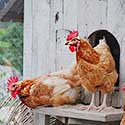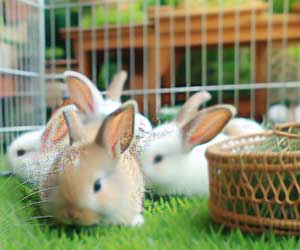Chickens and rabbits for meat and eggs in WW2 back gardens

One of the spearheads of the Government's campaign to keep Britain fed in WW2 was to encourage the public to keep rabbits and chickens for meat. Consequently householders set up ways to keep them in back their gardens. This page gives contributions from people alive at the time who did keep chickens and rabbits for meat. The first part of the page is about keeping chickens; it is followed with keeping rabbits and concludes with the feelings associated with keeping pets. Clearly it was keeping livestock was an extremely worthwhile activity as so little meat was available on ration.
____
By the webmaster: her early recollections and further research with contributions from others who lived at the time
Every one of the contributors and others I spoke to who kept chickens and rabbits had a man at home at the time, either because he was too old to be in the forces or because he was in what was called a reserved occupation. There must have been some women keeping chickens and rabbits. Certainly my mother never, my father being away in the forces.
Home-made incubators to increase the stock of chickens
contributed by Mary Wilkinson
A wooden 'orange box' (actually a greengrocers' vegetable box), into which Granny placed frequently refilled old stoneware hot water bottles, was our make-shift 'incubator' for hatching eggs, although the survival rate of the resulting chicks was, as far as I recall, not impressive! She kept this contraption next to the hot-water tank in the bathroom. In my memory, the smell lingers still!
Any eggs we didn't consume, Granny traded with neighbours for a little extra sugar or tea. I know for a fact, that any rationed sugar, was kept for my sister and me.
contributed by John Cole, family experience
My father had an incubator in the back bedroom, so we were completely self-sufficient for baby chickens, as we had a cockerel as well.
Feed for the chickens
contributed by John Cole, observation and family experience
It was possible to exchange a person's egg ration for chicken feed. This encouraged people to keep chickens, as the exchange paid off very well in terms of meat and extra eggs.
Our chickens were fed on a mash made up at home - bran from the corn merchant mixed with cabbage and left-overs - all stewed up together. Preparing the mash was a regular Saturday morning chore, making enough for the week. It made the house reek! But the eggs were plentiful.

Chickens feeding
contributed by Tim Sesemann (born 1938), recollections
For the chicken mash, every morning we boiled up potato skins with a bought flaky bran. I believe even this bran was allocated and overseen by the local police constable. We had neighbours who would save us their potato peelings in a lidded bucket kept at their front doorstep. In return I think we gave them eggs.
Keeping the chickens safe in air raids
Ros Collinscontributed by Ros Collins
As chickens were really important for food, they had to be kept safe like us in air raids. Our neighbours put their chickens into their Anderson shelter at night and spent nights with us in our Anderson shelter. We shared the eggs.
Killing and preparing the chickens for cooking
contributed by Peter Johnson, recollections
Chickens were killed for food as soon as they stopped laying eggs. We would all go and watch Dad wring a chicken's neck, and then we would sit round in a circle and pull out the feathers. It was an unpleasant task because the small feathers got up one's nose. The remaining ones went into the compost bin. Chickens were cooked the same day that they were killed.
Why keeping rabbits was so worthwhile
contributed by Peter Johnson
Rabbits are very good at reproduction all the year round. So families who kept rabbits had a never ending supply of rabbit and chips, stewed rabbit and rabbit pie. Rabbits were killed for eating whenever there were more rabbits than cages.

Rabbits kept for food in gardens
Feeding the rabbits
contributed by Tim Sesemann (born 1938), recollections
We had a shed where the rabbit cages were kept. At one time we had about ninety rabbits (many of them youngsters). There was one big old doe which had at least 14 litters (with about fourteen babies per litter). Every day we children had to collect their food of fresh green leaves from the roadsides and stuff a huge sack. It took forever to fill.
How to prepare a rabbit for cooking
contributed by Peter Johnson
To dispatch a rabbit, you suspended it by its back legs with the left hand. Then with your open right hand you struck it across the back of its neck with a swift chopping motion. The rabbit was next disembowelled with a cut down its stomach, and the innards removed. You could use a stick of wood if you objected to getting blood on your hands. The following day the skin was removed.
The value of a rabbit's skin in wartime
contributed by Peter Johnson
The skin was worth money from the rag and bone man who sold it on for winter boots and clothing. First, though, it had to be dried. My father stretched it tightly across a board, nailed it to the board and rubbed in salt. When the skin was dry, it was as stiff as the board, but was softened up by rubbing it together and pulling it over your knees.
Mole skins
(Mole skins could be dried in the same way. My first mole trap cost 2/6 [half a crown] from Woolworths but it soon paid for itself as we got 6d per skin. The skin was parcelled up and posted to an address in the Exchange and Mart. Mole skins were needed by plumbers for wiping lead joints, and had been used for the purpose ever since Roman times. Moles were bred on an industrial scale wherever the Romans took their civilization. Nowadays pipes are copper and plastic rather than lead.)
Skinning and gutting our rabbits ready for cooking
contributed by Tim Sesemann (born 1938), recollections
The old country 'gaffer' who would come and kill and gut our rabbits. He wore leather gaiters like Beatrix Potter’s Mr Macgregor. I expect he got the skins and a rabbit or two for his efforts.
Pets as food?
contributed by Tim Sesemann (born 1938), recollections
Churchill said we were allowed pets because they were good for morale and if food shortages got really bad we could always eat them.
Pet too precious to eat
contributed by Richard Ouston, a personal recollection
Each of our chickens was given a pet name and when the time came for one to be slaughtered, mother could not bear the thought of killing what she regarded as her pets. So we continued to have eggs but no chicken meat.
Meat for the dog
contributed by Neil Cryer, recollections
I seem to remember that the meat for our dog was poor quality in some way. Maybe it was already going off, but I can't remember the details or where it came from. It had to be boiled to make it safe, and I certainly do remember that this made a horrible smell.
| sources | webmaster | contact |
Text and images are copyright
If you can add anything to this page or provide a photo, please contact me.



